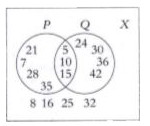If n(P)=13, then for which of the following values of n(Q) may result in n(P∩Q) being maximum ?
A
9
B
11
C
12
D
17
Video Solution
Text Solution
The correct Answer is:D
If P⊂Q, then n(P∩Q) is maximum.
|
Topper's Solved these Questions
- SETSBook:PEARSON IIT JEE FOUNDATIONChapter:SETSExercise:Level 2
Explore 21 Videos
- SETSBook:PEARSON IIT JEE FOUNDATIONChapter:SETSExercise:Level 3
Explore 8 Videos
- SETSBook:PEARSON IIT JEE FOUNDATIONChapter:SETSExercise:Essay Type Qns
Explore 5 Videos
- REAL NUMBERS AND LCM AND HCF Book:PEARSON IIT JEE FOUNDATIONChapter:REAL NUMBERS AND LCM AND HCF Exercise:level -11
Explore 1 Video
- SIMPLE INTEREST AND COMPOUND INTEREST Book:PEARSON IIT JEE FOUNDATIONChapter:SIMPLE INTEREST AND COMPOUND INTEREST Exercise:CONCEPT APPLICATION Level 3
Explore 9 Videos
Similar Questions
Knowledge Check
If n(P)=13, then for which of the following values of n(Q) may result in n(P∩Q) being maximum ?
A9B11C12D17If (pq)n−1=(qp)n−3, then the value of n is
A12B72C1D2Solve the following questions on the basis of following functions
Pn+1=Pn−Pn−1, P is the term of the sequence and P0=0,P1=1
Qn+1=Qn+Qn−1, Q is the term of the sequence and Q0=0,Q1=1
Which of the following can be a positive value of Qn+Pn+1?A55B234C146Dnone of these

From the above Venn diagram , find n(P∩Q)=__________.
View SolutionIf P+Q+R=180∘ then the value of ψn(Q−R)+qsin(R−P)+rsin(P−Q)
View SolutionIf 2log8N=p,log2N=qandq−p=4 then the value of N is
View SolutionIf 2log8N=p,log2N=qandq−p=4 then the value of N is
View SolutionSolve the following questions on the basis of the following questions on the basis of following functions
(a) P(n+1)=P(n)−P(n−1),P is the term of the sequence and P(0)=0,P(1)=1
(b) Q(n+1)=Q(n)+Q(n+1),Q is the term of the sequence and Q(0)=0,Q(1)=1
Which of the following can be a positive value of Qn+P(n+1)?
View Solution